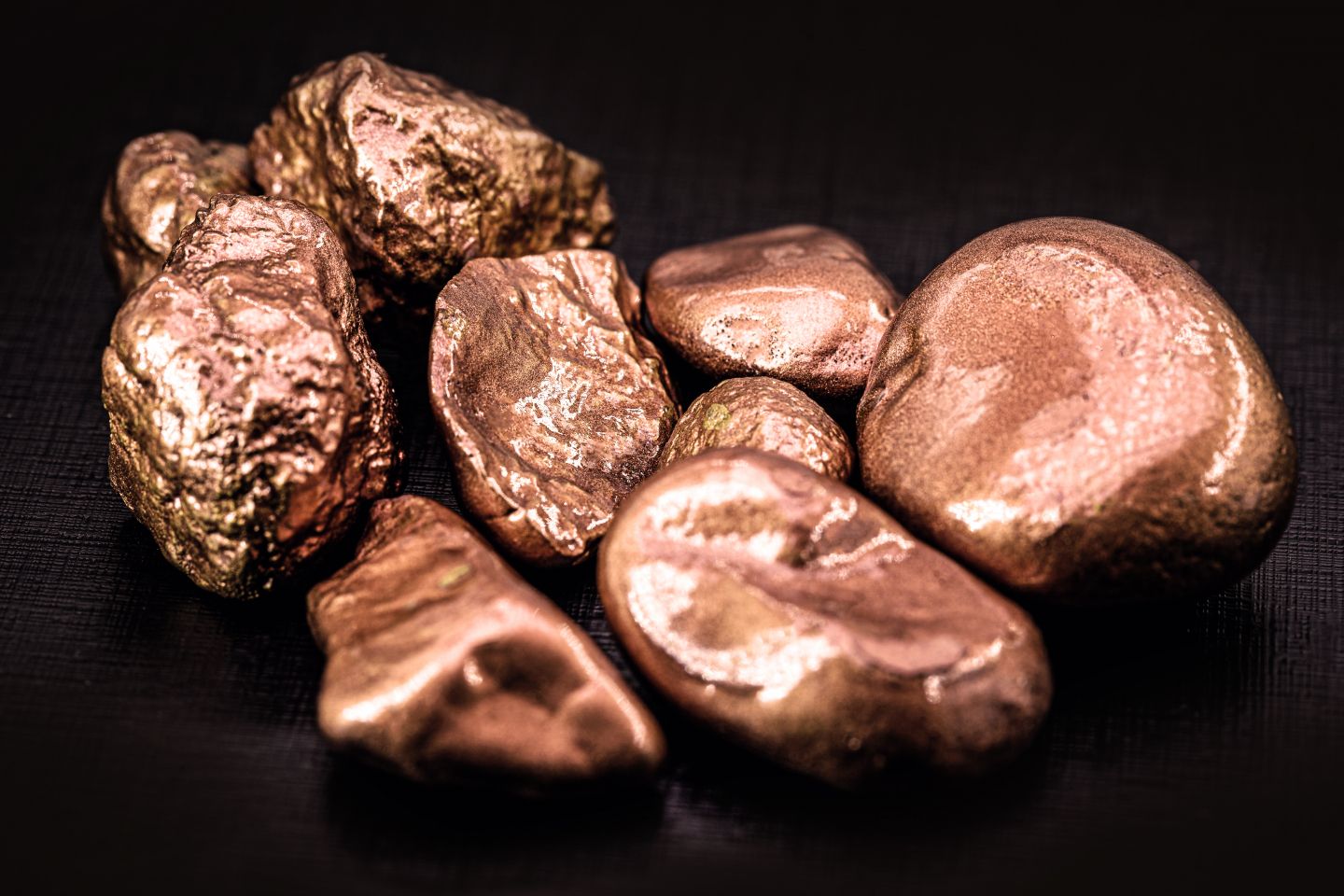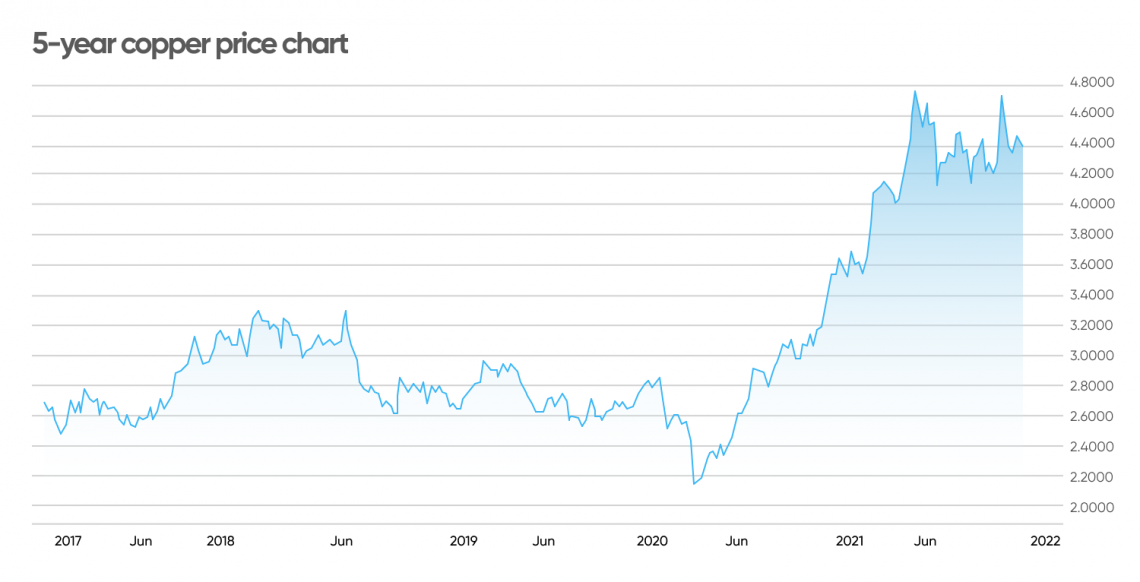Copper price analysis: Will tightened supply support prices?
How will slowing Chinese growth and electrification affect copper prices?
Copper fell in mid-November amid concerns over slowing Chinese economic growth and the presidential election in Chile, the world’s largest copper miner and producer.

China is the world's largest consumer of copper. Covid-19, recent power shortages and a sluggish property market have slowed China’s economic recovery. Copper is used in wires, pipes and tubes. Fewer construction projects and lower consumer demand could reduce consumption and put pressure on prices.
The International Monetary Fund (IMF) issued a statement in November on the Chinese economy:
Although the IMF has not revised its current forecast of China’s gross domestic product (GDP) growth of 8.0% in 2021 and 5.6% for 2022, as reported in the October World Economic Outlook, the organisation warned that “downside risks are accumulating”. According to the IMF, short-term risks include continued pandemic uncertainty, consumption weakness and elevated financial vulnerabilities.
“Copper fell as much as 1% early in the session amid concerns that China’s economy is slowing,” wrote Daniel Hynes, senior commodity strategist at ANZ Commodity, on 18 November.
The three-month copper contract traded on the London Metal Exchange (LME) fell to a five-week low at $9,410 a tonne on 18 November, but climbed above $9,500 the following day. The contract closed at $9,646.50 on 19 November, down 0.9% from a week earlier.
Despite the price dip, a technical analysis by Danish bank Saxo Markets on 19 November showed that a strong support level remained for copper.
“Copper remains range bound since March and the lack of momentum and conflicting fundamentals have reduced investor interest to the point that the open interest in LME copper futures has fallen to a nine-year low. However, a drop to a five-week low this week was quickly reversed as strong support continues to emerge ahead of $4 per cents in High Grade and $9,000 per tonnes on LME,” said Ole Hansen, head of commodity strategy at Saxo Markets.
Uncertainties over the outcome of Chile’s presidential election also supported the market. As the world’s largest copper miner and producer, the potential election of left-wing presidential candidate Gabriel Boric could mean an increase in mining royalties or export duties, which would increase copper production costs.
“The first round election for Chile’s next president will be held on 21 November, and given Chile and its next door neighbour Peru’s high share of global production, the result will be watched closely, given recent speculation that the left leaning candidate will raise taxes on mining companies to promote green hydrogen and reduce social inequality,” continued Hansen.
How will all these changing dynamics affect the copper price trend? Read this copper market analysis to learn about the latest market-moving copper price news and market outlook.
Copper price outlook and demand drivers
According to Peter Garnry, head of Equity Strategy at Saxo Markets, urban development and environmental concerns will continue to create a strong demand outlook for copper.
“Copper is an essential metal in our green transformation driven by electric vehicles and upgrades to our electric grid infrastructure. The ongoing urbanisation in the world is also driving construction, which is one of the key demand drivers for copper,” Garnry wrote on 19 November.
Garnry expects sectors related to electrification to overtake China as the leading demand driver for copper, noting:
According to research consultancy CRU, green applications could consume 1.2 million tonnes of refined copper in 2021, representing 5% of the total. Demand is predicted to rise every year this decade, reaching 6 million tonnes by 2030.
However, Garnry warned that significantly higher interest rates could curtail growth in construction and, in turn, cap copper demand.
Copper’s uses as a key metal in electrification and infrastructure have been widely recognised in the last few years. Data published by copper industry body the International Wrought Copper Council (IWCC) sees growing demand for copper in 2021-2022.
The IWCC expects refined global copper demand in 2021 to increase to 24.249 million tonnes, up 4.2% from the previous year. In 2022, demand for refined copper is forecast to rise by 2.1% to 24.762 million tonnes.
According to the IWCC, refined copper production in 2021 is projected to rise to 24 million tonnes, up 0.8% from 2020. In 2022, refined copper output is forecast to reach 24.89 million tonnes.
The supply and demand of refined copper in 2021 and 2022 is expected to be broadly balanced, said the IWCC.
In contrast, preliminary data from industry body International Copper Study Group (ICSG) indicates that the global copper market was in a 138,000 tonnes deficit in the first seven months of 2021. The data also showed that refined copper output has increased by 2.6% year-on-year to 14.36 million tonnes in the first seven months of 2021.
Global copper demand is estimated at 14.5 million tonnes in January to July, up 3.3% compared to the same time last year.
“The Covid-19 related global lockdown has had a notable negative impact on the world economy and subsequently on key copper end-use sectors in all regions ex-China. Although usage started to recover in the 2nd half of 2020, global demand remains below pre-pandemic levels in most countries,” wrote ICSG in its report.
Tight supply is expected to continue to support the copper value in the short-term. Many analysts remain bullish on the short-term copper price forecast. US investment bank Goldman Sachs’ copper price predictions for the next four years are significantly above $10,000 a tonne, exceeding the record-high of $10,500 in May this year.
While ANZ Commodity and Commerzbank expect copper prices to be under $10,000 a tonne. See the table below.
According to a Reuters poll in late October, market participants anticipate copper prices to average at $9,000 a tonne in 2022.
Falling copper inventory in SHFE and LME
Copper inventory held in metal exchanges has been falling this year, reaching multi-year lows, which underpinned global supply tightness and support prices.
Amid tight physical supply, premiums paid for deliveries have increased to a six-year high, according to ANZ Commodity.
Copper stock held in Shanghai Future Exchange (SHFE) warehouses continued to fall to a fresh 12-year low. Copper inventories were last at 34,918 tonnes for the week ending on 19 November, SHFE data shows.
“The premium paid by buyers for copper in China rose to a six-year high of CNY2,200/tonne ($344.80) on Friday. This came after inventories on the Shanghai Futures Exchange fell to their lowest level since 2009,” said the aforementioned Hynes on 22 November.
LME copper open tonnage was last at 62,575 tonnes on 18 November, the lowest since 2009.
Note that this article does not constitute financial or investment advice. Always do your own research before investing. Your investment decision should be based on your attitude to risk, your expertise in this market, the spread of your portfolio and how comfortable you feel about losing money. Never invest more than you can afford to lose. And keep in mind that past performance is no guarantee of future returns.
FAQs
Why is the copper price going up?
Copper prices have been rising this year as global demand outstripped supply. Demand is mainly driven by the post-Covid recovery and electrification. China is the largest consumer of the metal, and concerns of slowing economic growth in the country tends to weigh on copper prices.
Will copper prices go up or down?
Some analysts are bullish on copper prices, predicting prices to average $9,000 a tonne and above in 2021 to 2025. However, forecasts can be wrong and market trends can change.
Whether you believe those predictions is a decision only you can make. As always, you should be aware that the past price performance is no guarantee of future returns. And you should never invest more than you can afford to lose.
What affects the price of copper?
Copper prices are driven by supply and demand fundamentals. When consumption of the metal exceeds the supply, this will support copper prices and vice versa.
The global electrification trend is expected to increase copper demand and is bullish for copper prices. However, other factors such as slowing Chinese economic growth and interest rate hikes are bearish for metal prices.